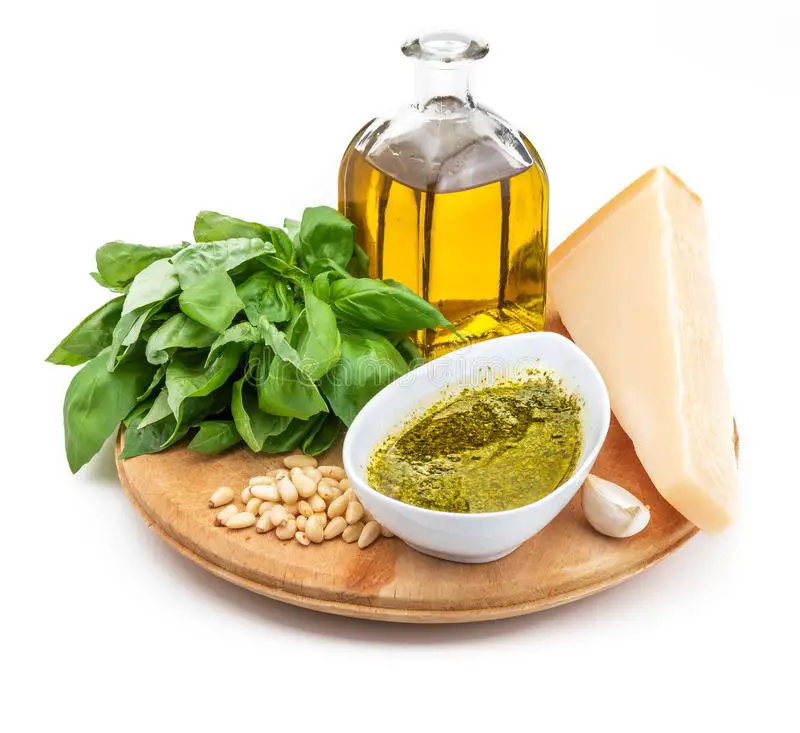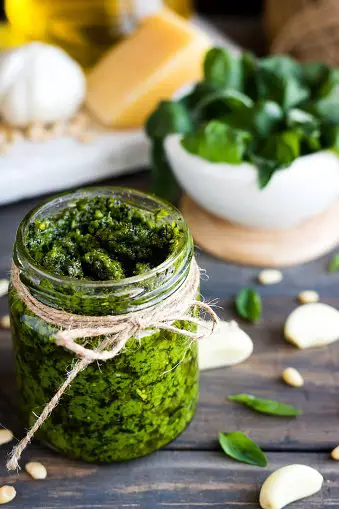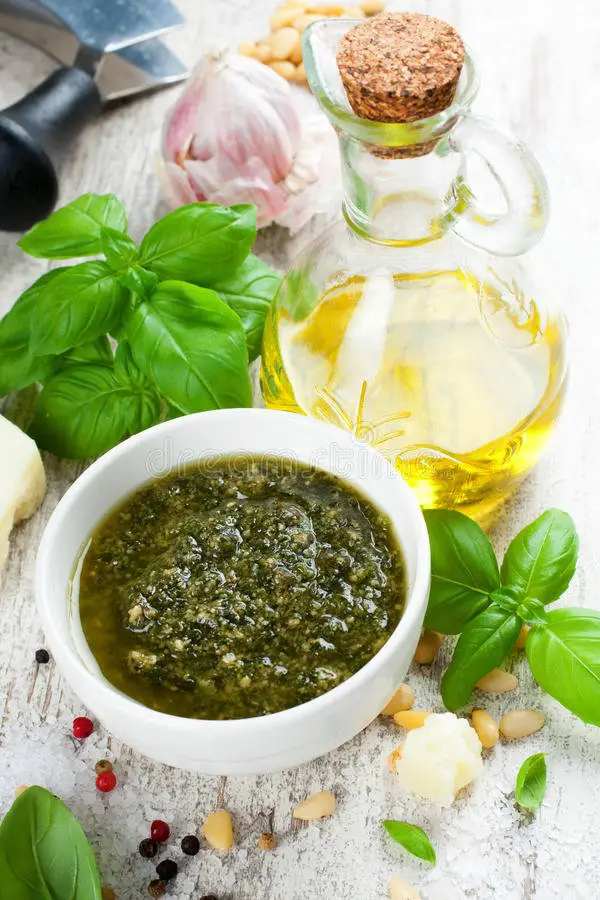Pine Nuts Or Other Nuts/seeds
Pine nuts are the traditional choice . Pine nuts are tender, buttery and high in fat, so they yield smoother, silkier pesto.
On the downside, pine nuts are prohibitively expensive. I save money by using raw almonds, walnuts, pecans or pepitas instead. Almonds are the most neutral option, so I used them for the pesto you see here. Theyre all delicious in their own way, though.
I typically toast the nuts first to really bring out their flavor and add an extra-savory edge to the pesto.
The Best Basil To Use For Pesto
Did you know there are 60 different varieties of basil? Luckily, most stores only sell one or two kinds, making it easy to choose. Thai basil is really the only kind that’s too pungent for this recipe. When buying fresh basil, look for vibrant green leaves with no sports or wilting.
Dried basil is fine for flavoring sauces, soups, and other dishes. But its flavor is very different from fresh basil. You need fresh basil leaves to make pesto.
Variations To Cooking With Pesto
When making this pesto sauce recipe, you might want to change it a bit. The most obvious ways to change pesto is by adding more or less of the ingredients in the recipe. This works because it gives the pesto the best taste for how you like it.
Another way to make changes to this pesto sauce is to change the herbs. While I prefer a basil based pesto there are others who make the pesto using a wide variety of other green ingredients.
- Parsley or cilantro
- Kale If you choose to use kale, remove the stems and blanch it quickly.
- Spinach
- I have even heard of asparagus pesto however, I have never made it myself.
Another simple swap that can change the taste of the pesto is using walnuts rather than pine nuts. Pine nuts are traditionally used in pesto sauce but for some, they either balk at the price or simply do not like pine nuts. Walnuts can be substituted without much change to the taste.
Recommended Reading: How To Remove Hot Sauce Stain From Carpet
How To Make Pesto Sauce With Basil
Try this recipe for Pesto Geneovese that Matthew demonstrates in the video above.
Making basil pesto is a simple procedure. You’ll start with a few simple pesto ingredients: a few cups of packed fresh basil, 3 or 4 peeled cloves of garlic, freshly grated Parmesan cheese, extra-virgin olive oil, and pine nuts. There’s not much prep work involved.
You’ll simply blend together the basil, nuts, garlic, and cheese in a food processor . And then slowly pour in the olive oil while mixing. Adding salt and pepper at the end to taste. And that’s how to make basil pesto sauce. That’s essentially all there is to it. There are, of course, tasty variations on this basic recipe.
Related: Make Healthy Pesto Three Ways with this Basic Recipe Formula
Bright Green Basil Pesto That Won’t Fade

One of the frustrating things we run into is that pesto quickly oxidizes, turning from it’s beautiful bright green color into something more on the brownish side. I have two small tips that I use in my video below, and they have made all the difference:
- Blanch the fresh basil. This step takes just a few seconds. You place the basil in a boiling pot of water for 5 to 10 seconds max, then transfer it quickly to an ice bath to stop cooking. And before using it, make sure you wring out all the water. Blanching is meant to kill off the decomposing enzymes that are responsible for turning the leaves brown. Fine Cooking also claims that this trick helps create a better emulsion.
- Use a little citrus. Juice of ½ lemon adds loads of brightness to your homemade basil pesto. I think it enhances the flavor and also aids in keeping that bright green color.
Now, let’s get to the question of the day: how do you make it?
You May Like: The Classic Hot Sauce Pepper X Edition Scoville Units
Is Pesto Bad For You
Pesto has gotten a bad rap because it contains a lot of fat from nuts, cheese, and oil. However, most of these fats are the heart-healthy kind. Plus, a little bit of pesto goes a long way to adding flavor to your favorite dishes.
In addition, some of the ingredients in pesto have other health benefits such as lowering the risk of heart disease, diabetes, cancer, and Alzheimers and dementia.
How To Properly Store Basil
Fresh basil leaves are delicate and quite a treat to have on hand. To properly store them and extend the shelf life, do not rinse first! Simply wrap the leaves in a damp paper towel, place them in a plastic bag and do not seal. The damp towel keeps them fresh without too much condensation which could cause darkening of the leaves. This should keep them fresh for 3 to 7 days.
Pin this recipe to save for later
Don’t Miss: Rao’s Sauce Low Carb
How To Store Pesto
Pesto can be refrigerated for up to five days. Pour your pesto into a small glass or plastic storage container. Add a thin layer of olive oil to the top, which will help prevent air from oxidizing the basil and turning the pesto brown. Cover the dish tightly.
There are two options to freeze your pesto. You can pour your whole batch into a freezer-proof dish, leaving about an inch of space at the top for expansion. Pour a thin layer of olive oil over the top of the pesto, then seal the dish tightly. Place it upright in the freezer to keep the oil in place until it freezes.
Nancy Mock for Taste of Home
You can also freeze pesto in ice cube trays, to easily grab a cube or two to toss into your recipes. Spoon the pesto into an ice cube tray, then cover it tightly. Freeze until the pesto is firm. Pop out the pesto cubes and store the cubes in a tightly-sealed freezer bag for up to one year.
Learn How To Make The Best Pesto With This Homemade Fresh Basil Pesto Recipe Full Of Tips Tricks And Recipe Variations Youll Never Settle For Store
This homemade pesto recipe instantly elevates anything it touches from pasta to chicken, fish, sandwiches, vegetables, eggs, salads, etc. Itsdeliciously cheesy, garlicky and herbaceous brimming with peppery basil, salty Parmesan, nutty pine nuts, zingy garlic and rich olive oil. Best of all, this basil pesto recipe is easy to make in a food processor in less than 10 minutes, is a brilliant freezer standby and heads above any processed jars. Keep the pesto sauce classic or Ive included all sorts of variations including cashews, almonds, walnuts, arugula, spinach, kale etc. Lets pesto!
Don’t Miss: Keto Chick Fil A Sauce Recipe
What Is Pesto Made Of
Pesto was historically made from ingredients that were crushed or pounded with a mortar and pestle. This method dates back to Roman times when Genoans would crush together walnuts with some herbs and garlic.
Although you can still make pesto the traditional way, its much, much quicker to whip it all together in a blender or food processor. The most popular way to make pesto is the way I have it listed here: using basil, garlic, olive oil, pine nuts, and a hard cheese like parmesan.
How To Use Mint Pesto
That versatility I just mentioned? Here are a few ideas!
- Smear it on a baguette with goat cheese for a sandwich.
- Swirl it into yogurt for a tasty dipping sauce for vegetables.
- Place a slice of feta on a cracker and dollop a little mint pesto on top.
- Mix mint pesto and feta into ground lamb for a tasty lamb burger.
- Toss it with warm small red or b-sized potatoes.
- Spread some over broiled or grilled fish.
Don’t Miss: How To Get Rid Of Soy Sauce Stains
Make Your Pesto Vegan
There are ways to turn traditional pesto into vegan pesto and still be delicious. The easiest way is to just omit the cheese altogether. This pesto will still have all the flavor and intensity of the basil and garlic, and texture from the pine nuts. If you dont want to sacrifice that umami flavor that cheese brings, try adding nutritional yeast. Different from yeast for baking, nutritional yeast is a vitamin-packed food that has a slightly nutty, slightly cheesy flavor. Its a great way to add cheese flavor to dairy-free and vegan dishes. Begin by adding 1/4 cup of nutritional yeast to your pesto ingredients, then taste and add more if you wish.
How To Make Pesto Sauce:

To make homemade pesto, simply
Don’t Miss: Rao Spaghetti Sauce Where To Buy
Use The Pulse Function
Food processors are perfect for blending pesto quickly, but some folks make the mistake of overprocessing the ingredients. Its best to use the pulse function to chop your basil and incorporate other ingredients like nuts, cheese and garlic. These short bursts of power process the ingredients without turning them to liquid. Once you begin adding the oil, you can let the food processor run on low speed to emulsify the sauce.
Overview: Ingredients In Homemade Basil Pesto
For ingredient substitutions, see my recipe notes.
- Basil: Fresh basil leaves are the base of this pesto recipe. Rinse and pat dry before using.
- Pine Nuts: Pine nuts add structure to the pesto. If Im having trouble finding pine nuts, sometimes Ill swap them for walnuts, pistachios, or almonds. For a nut-free version, try cooked and cooled edamame, pumpkin seeds, hemp seeds, or sunflower seeds.
- Parmesan Cheese: Parmesan cheese adds a little saltiness and helps the pesto stick together. Its honestly the best part.
- Garlic: It goes without saying that garlic adds incredible flavor to homemade pesto. For even more flavor, try using roasted garlic.
- Olive Oil: Not only does olive oil add flavor, it also helps create an unbeatable creamy and rich consistency.
- Lemon Juice: 1 teaspoon of fresh lemon juice brightens everything up and really helps the other flavors shine. Many recipes dont call for it, but I highly recommend it. Trust me on this one!
- Salt & Pepper: Both add flavor.
Make it your own: For a twist, try adding your favorite herbs like cilantro, mint, or parsley, your favorite spices like cayenne, ground ginger, or paprika, or add a dash of your favorite hot sauce.
You May Like: Ragu Alfredo Sauce Walmart
Expert Tips And Tricks
- Not into pine nuts? Swap cashews or even walnuts in a pinch.
- If you want to be conservative on the salt, start with 1/4 teaspoon. Taste and add more as desired.
- Additional lemon juice can be added for a more lemony flavored pesto so good!
- To freeze pesto, I like to use ice cube trays. Fill up a tray with dollops of pesto, freeze, then pop the pesto ice cubes out and store in a Ziplock bag. That way, you can portion out how much pesto you want to/need to thaw for all your pesto cooking needs.
You Can Blanch The Basilor Not
There are dueling opinions among cooks about whether or not to blanch basil leaves before turning them into pesto. When cut, basil leaves will start to oxidize and turn brown. However, if the leaves are blanched first , they will keep their bright green color. The downside is the added work and time to blanch the leaves. Also, some say that blanching diminishes the vibrant flavor of the basil.
If the pesto youre making will be eaten quickly, youre fine to skip blanching. For pesto that youre planning to store or freeze for a while , you can blanch and dry your basil leaves before processing them.
You May Like: How To Make Shrimp Fettuccine Alfredo With Ragu Sauce
How To Make Pesto From Scratch:
Like I said earlier, I am using a food processor in this quick pesto recipe. And once you’ve blanched the basil, it really takes two steps from there:
- Blend. Add the basil , toasted pine nuts or walnuts , fresh garlic , and lemon juice in the bowl of a food processor fitted with a blade. Cover and run the processor. As the processor is running, slowly drizzle in the extra virgin olive oil from the top opening.
- Mix in the cheese. Transfer the basil mixture to a bowl. Add the grated Parmesan cheese . If you need to, add more extra virgin olive oil to help mix it. Watch for the consistency you like.
- Season. Taste and season with a pinch of kosher salt and black pepper to your liking.
How To Make Basil Pesto Sauce
Have you ever wondered how to make basil pesto sauce? You only need 4 high-quality ingredients, namely fresh basil, pine nuts, cheese and garlic for this fresh pesto recipe. The best part of making this basil sauce is how easily it comes together in a food processor.
This, my friends, is the ultimate fast food.
It really is!
All you need are a few quality ingredients, a whirl in your food processor and just like that presto. you have pesto!!!
Granted, this is not the authentic way to make pesto. In fact, the word pesto originates from the Italian verb pestare which can be loosely translated as to step on, to press or to crush.
Naturally, a mortar and pestle quickly come to mind when thinking of pesto. You could, of course, make your pesto this way, but an immersion blender or a food processor facilitates the whole process.
In fact, this uncooked herb sauce is made in less than 10 minutes and when combined with your favorite pasta, you have Pasta al pesto -a quick basil pesto pasta meal.
Since Italian cuisine is all about the quality of the ingredients, lets first take a closer look at the ingredients and then how easy this homemade pesto comes together in a food processor.
Also Check: Tomatoes And Gout
How To Make Homemade Pesto Sauce Recipe
Place 2 cups of fresh basil leaves into the bottom of a food processor. Pack them down so that there is plenty of room for the rest of the ingredients.
Add c. of pine nuts.
Place 3 cloves of minced garlic in the processor.
Sprinkle in ½ cup of Parmesan cheese.
Top the cheese with salt and pepper to taste.
Pour in ½ cup of sunflower oil.
Place the lid on the food processor, and blend for 3-5 minutes until you get the consistency you desire for your pesto. If your pesto seems too dry, you can add a bit more sunflower oil to the mixture.
Use immediately. You can also place the pesto into an airtight container and keep it in the fridge for up to 5 days, or the freezer for 3-4 weeks.
How To Make It

You can make the pesto sauce while the pasta is boiling. Its quick and easy!
Melt the butter in a large skillet over medium heat, add the cream and whisk to combine. Once the cream is warmed up add the pesto and whisk again.
Cook the sauce for a minute or two dont let it boil. Add the parsley and Parmesan cheese and stir until the cheese melts into the sauce.
You can keep the sauce on medium-low heat if youre still waiting on the pasta to cook. Just give it a whisk every so often.
Once the fettuccine is al dente, drain it and add it to the pan with the sauce. Use tongs to toss it in the pesto cream sauce. Its okay if a little of the pasta water transfers over with the fettuccine it will just add to the sauce.
Add a few squeezes of fresh lemon juice, toss again, and serve. Its best enjoyed when its made.
Also Check: Raos Spaghetti Sauce
Tips For Making Homemade Pesto
- Always check your nuts for freshness. Rancid nuts can really spoil the recipe and ruin the taste. I keep my pine nuts in the freezer since they are so expensive and they last longer in the freezer.
- Add more olive oil to remedy any dry pesto. Make sure to do this while the food processor is running to allow the olive oil to emulsify and create a looser texture. Just blend until you reach your desired consistency.
- Thin out pesto with pasta water if youre using it as a sauce. I usually keep my pesto thicker so that its more versatile as a spread. But when adding to pasta, the starchy pasta water is a great way to thin out the pesto sauce.
- Toast the pine nuts for enhanced flavor. While this is not necessary to make pesto, toasting helps release the oil in the pine nuts to take the pesto to the next level.
What Does Pesto Taste Like
The strongest flavors in this sauce come from the basil and garlic, which is then balanced by the olive oil and pine nuts. Since pine nuts are an oily type nut they bring a buttery taste to the spread. Depending on the type of cheese youll also have hints of salt. You should be able to taste all the flavors of the ingredients added into this fresh sauce.
Don’t Miss: Lemongrass Basil Simmer Sauce
